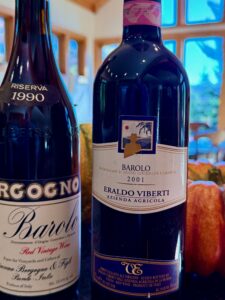As I sit here composing this column and look out my office window at the first snowflakes of the year gently falling, it truly is beginning to look a lot like Christmas – and Hannukah. I can also tell because many of my friends are calling asking me to suggest a wine for the special people in their lives. And for this wine lover, it’s not often I am forgiven for casting prudence to the wind and plunking down some serious green for a bottle of red or white.
I‘ve already been perusing the shelves of my favorite wine shops in search of that special bottle. The good news is that there is an abundance of wine from all over the world available in any number of price ranges to meet just about any budget. And when you gift wine, particularly to someone close to you, there is a good likelihood you’ll be invited to sip along with the giftee once that special bottle is uncorked. Whenever I give the gift of wine, especially during the holiday season, I always ruminate over what type of holiday entrée it will pair best with that will present the best opportunity for gastronomic synergy. In my particular household, I’m thinking about Christmas Eve and Christmas Day meals and the wines that will make the feasts memorable.
 A
few
of
my
favorite
things
A
few
of
my
favorite
thingsIn our house, my wife and I divide up responsibility for the two meals. I take Christmas Eve and she is chef de cuisine for Christmas Day. As one who was raised in a Catholic Italian family, I will spend all day Christmas Eve preparing and cooking seafood dishes in a meal that will resemble ‘The feast of the seven fishes’. After five or six hours of frying, boiling, steaming, smoking and poaching sea creatures, I will be worn out, cranky, smelly and in serious need of a shower and a sip or two of wine. My choice to soothe my weary body and reinvigorate my spirit is Champagne or sparkling wine which is also an excellent way to kick off the activities as well as pairing seamlessly with all manner of seafood.
On Christmas day, my wife will prepare a more traditional American holiday meal featuring a standing rib roast. After working her culinary magic, she will emerge from the kitchen smiling broadly, full of Christmas cheer, and smelling of lavender. Of course, this meal demands a big red wine such as cabernet sauvignon or even a Christmas Claret (Bordeaux). So today, I’m going to share a list of wines I would love to find under my Christmas tree and which I think your friends will enjoy too. Many of these bottles just happen to include wines that would go particularly well with our holiday meals.
Cabernet Sauvignon, Bordeaux Red or Bordeaux -style blends : Chateau Lynch Bages; Quilceda Creek Cabernet Sauvignon; Alexander Valley Vineyards Cyrus Red; Joseph Phelps Insignia; Dominus; Harlan Estate Red; Chateau La Dominique; Groth Cabernet Sauvignon Reserve; Chateau Gruaud Larose; Merryvale Profile; Chateau Cos d’Estournel; Ridge Monte Bello Cabernet Sauvignon; Chateau Pontet Canet; Leoville Las Cases; Heitz Martha’s Vineyard Cabernet Sauvignon; and Ornellaia (super Tuscan blend).
Champagne
and
Sparkling
wines:
Taittinger
Comptes
De
Champagne
Rose;
Nicholas
Feuillatte
“Blue
Label”
Brut;
Mumm
Napa
Cuvee
(sparkling);
Paul
Bara
Brut;
Veuve
Cliquot
Brut;
Roderer
Estate
(sparkling);
Krug
Grande
Cuvee
Brut;
Perrier
Jouet
Grand
Brut;
Iron
Horse
Russian
Cuvee
(sparkling).
Happy Holidays!
John Brown is also a novelist. His latest book – Augie’s Wine –is now available to order online or at his website wordsbyjohnbrown.com. His first two books– Augie’s War and Augie’s World – are also available online and at bookstores around the state. You can find out more about his novels, and review all his archived Vines & Vittles columns at wordsbyjohnbrown.com

 My
grilled
turkey
stuffed
with
ancho
chilies,
cornbread
and
chorizo
My
grilled
turkey
stuffed
with
ancho
chilies,
cornbread
and
chorizo Chateauneuf
Du
Pape
–
an
excellent
choice
for
Thanksgiving
Chateauneuf
Du
Pape
–
an
excellent
choice
for
Thanksgiving Two
of
my
favorite
Barolo
labels
Two
of
my
favorite
Barolo
labels Pork
Milanese
–
Molto
Bene!
Pork
Milanese
–
Molto
Bene! Chehalem
Willamette
Valley
Pinot
Noir
Chehalem
Willamette
Valley
Pinot
Noir Chef
Noah’s
Chanterelle
Pasta
Chef
Noah’s
Chanterelle
Pasta